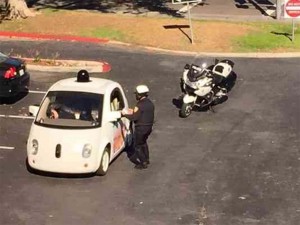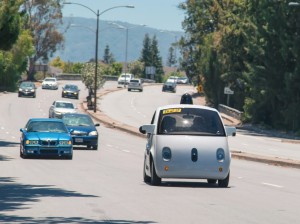
A Mountain View, CA police officer gives a warning to a Google Car for driving too slow. Photo courtesy Google autonomous vehicle blog.
A traffic stop in the Silicon Valley suburb of Mountain View has raised a number of new question about autonomous vehicles, among other things who gets a ticket if a self-driving car is pulled over?
A police officer stopped one of the bubble-shapped “Google Cars” last week because it was tying up traffic, driving at only 24 miles per hour in a 35 mph zone. The person behind the wheel of the two-seater was ultimately let go without a citation, the cop apparently more interested in finding out how the autonomous vehicle works,
He used the stop to “learn more about how the car was choosing speeds along certain roadways and to educate the operators about impeding traffic,” explained a post on the blog operated by Google’s autonomous vehicle unit. “Driving too slowly? Bet humans don’t get pulled over for that too often,” the post noted.
It wasn’t the first time the police have been involved with Google vehicles, however. Various self-driving prototypes operated by the tech giant have so far been involved in 17 minor collisions since May 2010, Google has reported. Most of those were modified Lexus and Toyota products, but the latest traffic stop involved a specially designed vehicle produced for Google by Detroit supplier Roush Enterprises.
(New studies find growing consumer interest in advanced safety and autonomous vehicles. Click Here for more.)
Google has been operating the new prototypes – of which it eventually plans to have 100 – near its Silicon Valley headquarters, as well as in Austin, Texas, a major high-tech center. Initial versions of the bubble-cars have conventional controls, but the company hopes to eliminate steering wheel and pedals from later models, if given regulatory approval, leaving only an emergency stop button.
For the time being, the prototypes are limited to speeds of no more than 25 mph, a potential problem when they’re operated on public roads with higher limits – many of them near in hilly Silicon Valley providing limit opportunities for other motorists to pass.
The lower speed is meant to reduce the potential for accidents and injuries. Despite experiencing 17 crashes so far, state records indicate only one involved minor injuries. And Google officials have emphasized that in all the collisions it was the other, human driver at fault. Legally, anyway.
The Silicon Valley giant also notes that its autonomous vehicles have so far logged 2.2 million miles of testing, more than half of that in self-driving mode. But a recent study by the University of Michigan Transportation Research Institute, or UMTRI, raised a red flag, cautioning that the number of crashes involving those autonomous vehicles is several times higher than for conventional vehicles.
(Autonomous vehicles involved in unusually high number of real-world crashes. Click Here for the story.)
Google officials have acknowledged the need to develop more sophisticated programming for their autonomous vehicles that can drive more like a human. That might mean going through a yellow light, rather than immediately slamming on the brakes under all circumstances, so there are fewer rear-end collisions.
It’s unclear whether Google will now limit where its autonomous bubble-cars operate or raise the speed they can operate at.
In a blog post, the company defended its policy, noting, “We’ve capped the speed of our prototype vehicles at 25 mph for safety reasons. We want them to feel friendly and approachable, rather than zooming scarily through neighborhood streets.”
So far, at least, “we’ve never been ticketed,” the post added. But it appears it may be ticking off motorists – and police officers – forced to travel behind it well below the speed limit.
(For 1st to test at new Mcity autonomous vehicle proving grounds. Click Here for the story.)


Nevada had the highest single vehicle rollover per driven miles in the United States with the 55mph energy wasting years. Many people would fall asleep then wake up as their car or truck was drifting off the pavement then over react and turn the steering wheel and flip the vehicle. The first solution was raising the speed limit and the second was rumble strips on the side. Sometimes speed kills. Sometimes not enough speed kills at least with long boring desert landscapes and human drivers. It sounds though with with autonomous vehicles the could up the speeds out of the metro areas.
Does anyone in an autonomous vehicle need to be licensed? It seems, if there is no steering or other controls, a license should not be required, hence, “car, take the kids to school.”
Currently, the law in those states with autonomous regs requires someone in the car, with a legitimate license, sitting behind the wheel. Google will require new regs before it can put the driverless model on the road.
Paul E.
There will need to be new state and Federal laws regarding AVs to protect consumers from the many possible safety issues with AVs. Simple things like making all yellow caution traffic lights in the U.S. operate at a consistent rate of change to avoid the rear end collisions the Google cars have already experienced will be required. State vehicle safety inspections annually of all AVs will be a must. Proof that the vehicle electronics/controls can’t be hacked prior to sale of any AV to the public should be imperative, etc.
Only Federal laws that are properly enforced will result in remotely safe AVs being sold to the public as there is a clear rush-to-market mentality in the AV industry by both AV makers and some governmental agencies looking to profit from the rush-to-market mentality. People will certainly die from negligence of all concerned parties if authorities get this wrong.